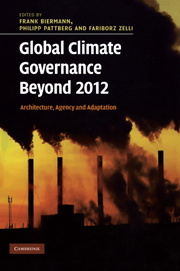Book contents
- Frontmatter
- Contents
- List of contributors
- Preface
- List of abbreviations
- 1 Global climate governance beyond 2012
- Part I Architecture
- 2 The architecture of global climate governance
- 3 The consequences of a fragmented climate governance architecture
- 4 Environmental effectiveness and economic consequences of fragmented versus universal regimes
- 5 Developing the international carbon market beyond 2012
- 6 The overlap between the UN climate regime and the World Trade Organization
- 7 An architecture for long-term climate change
- 8 Shaping the architecture of future climate governance
- Part II Agency
- Part III Adaptation
- Index
- References
3 - The consequences of a fragmented climate governance architecture
a policy appraisal
Published online by Cambridge University Press: 05 July 2014
- Frontmatter
- Contents
- List of contributors
- Preface
- List of abbreviations
- 1 Global climate governance beyond 2012
- Part I Architecture
- 2 The architecture of global climate governance
- 3 The consequences of a fragmented climate governance architecture
- 4 Environmental effectiveness and economic consequences of fragmented versus universal regimes
- 5 Developing the international carbon market beyond 2012
- 6 The overlap between the UN climate regime and the World Trade Organization
- 7 An architecture for long-term climate change
- 8 Shaping the architecture of future climate governance
- Part II Agency
- Part III Adaptation
- Index
- References
Summary
Introduction
This chapter complements the analysis in Chapter 2 by a policy-oriented inquiry of how different degrees of fragmentation of governance architectures are likely to affect the environmental effectiveness of policies. Our study relates here to an area of widespread contestation in academic and policy writing. It is often maintained, as we describe further below, that a more integrated climate governance architecture would promise higher effectiveness. This claim, however, is also contested, and several authors emphasize the potential benefits of a multitude of agreements, institutions and approaches within an overall fragmented architecture. Claims in favour and against stronger or lesser fragmentation are found in a variety of literatures, ranging from international relations and international law to the comparative study of environmental policy. We review these claims here, organized along the questions of: (1) the relative speed of reaching agreements; (2) the level of regulatory ambition that can be realized; (3) the level of potential participation of actors and sectors; and (4) the equity concerns involved.
The four aspects of speed, ambition, participation and equity are interrelated and eventually will have a bearing on overall governance performance. Based on our typology in the previous chapter (Biermann et al., this volume, Chapter 2), we view the propositions as a continuum of different claims as to the relative positive or negative consequences of higher (conflictive) or lower (synergistic) degrees of fragmentation.
Methodology
For this qualitative assessment, we reviewed and discussed the state of the art in the scholarly literature regarding the promises or perils of fragmentation of global governance architectures. We analysed different bodies of literature, comprising writings on international law, international relations and cooperation theory in general as well as more specific writing on global environmental governance and institutional interlinkages. We contrasted these bodies of literature with evidence from current climate negotiations. As a further ‘reality check’, we discussed the pros and cons of fragmentation repeatedly with international experts of the Contact Group of the ADAM Project and other experts of the project.
- Type
- Chapter
- Information
- Global Climate Governance Beyond 2012Architecture, Agency and Adaptation, pp. 25 - 34Publisher: Cambridge University PressPrint publication year: 2010
References
- 4
- Cited by



